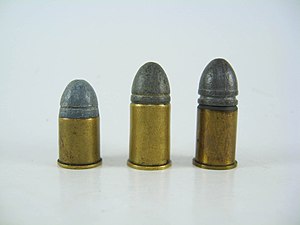.442 Webley
| .442 Webley | ||||||||||||
|---|---|---|---|---|---|---|---|---|---|---|---|---|

.44 Bull Dog (Peters), .442 Webley (UMC) and .442 Revolver (Eley)
|
||||||||||||
| Type | Revolver | |||||||||||
| Place of origin |
|
|||||||||||
| Production history | ||||||||||||
| Designed | 1868 | |||||||||||
| Produced | 1868-1950s | |||||||||||
| Specifications | ||||||||||||
| Case type | rimmed, straight | |||||||||||
| Bullet diameter | .444 in (11.3 mm) | |||||||||||
| Neck diameter | .448 in (11.4 mm) | |||||||||||
| Base diameter | .454 in (11.5 mm) | |||||||||||
| Rim diameter | .500 in (12.7 mm) | |||||||||||
| Case length | .657 in (16.7 mm) | |||||||||||
| Overall length | 1.133 in (28.8 mm) | |||||||||||
| Rifling twist | 1:20 | |||||||||||
| Primer type | Large | |||||||||||
| Ballistic performance | ||||||||||||
|
||||||||||||
| Source(s): Barnes & Amber 1972 | ||||||||||||
The .442 Webley (also known as the ".442 Revolver Centre Fire" in Great Britain, the "10.5x17mmR" or ".442 Kurz" in Europe, and ".44 Webley" or ".442 R.I.C." in the United States) is a British centrefire revolver cartridge.
Introduced in 1868, the .442 (11.2mm) Webley round was used in the Webley RIC revolver. This was the standard service weapon of the Royal Irish Constabulary (RIC, whence the revolver's name), which were also chambered in (among others) .450 Adams and 476/.455. Lt. Col. George Custer is believed to have carried a pair of RIC revolvers (presented to him in 1869 by Lord Berkley Paget) at the Battle of the Little Bighorn.
A black powder round, the .442 originally used a 15-19 gr (0.972-1.23 g) charge behind a 200-220 gr (13-14.3 g) bullet. This loading was later joined by a smokeless variety.
At one time, the .442 Webley was a popular chambering in self-defence or "pocket" guns (so named for being designed to be carried in a pocket, what today might be a known as a snubnose or carry gun), such as the widely copied Webley British Bulldog pocket revolver. The .442 Webley should not be confused with the short, low-powered .44 Bulldog cartridge offered by American manufacturers as an optional loading for .442 Webley caliber arms.
...
Wikipedia
